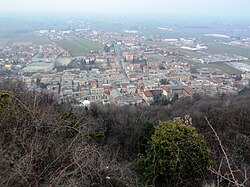Cavour (TO)
| Cavour | ||
|---|---|---|
| Comune | ||
| Comune di Cavour | ||

Cavour seen from its Rocca
|
||
|
||
| Location of Cavour in Italy | ||
| Coordinates: 44°47′N 7°23′E / 44.783°N 7.383°ECoordinates: 44°47′N 7°23′E / 44.783°N 7.383°E | ||
| Country | Italy | |
| Region | Piedmont | |
| Province / Metropolitan city | Turin (TO) | |
| Government | ||
| • Mayor | Piergiorgio Bertone | |
| Area | ||
| • Total | 49.1 km2 (19.0 sq mi) | |
| Elevation | 300 m (1,000 ft) | |
| Population (30 September 2010) | ||
| • Total | 5,642 | |
| • Density | 110/km2 (300/sq mi) | |
| Demonym(s) | Cavouresi | |
| Time zone | CET (UTC+1) | |
| • Summer (DST) | CEST (UTC+2) | |
| Postal code | 10061 | |
| Dialing code | 0121 | |
| Patron saint | St. Lawrence | |
| Saint day | First Sunday in August | |
| Website | Official website | |
Cavour (Italian pronunciation: [kaˈvur]; from the Piedmontese toponym, Cavor [kaˈʋʊr]; Latin: Caburrum) is a comune (municipality) in the Metropolitan City of Turin in the Italian region Piedmont, located about 40 kilometres (25 mi) southwest of Turin.
Cavour borders the following municipalities: Macello, Vigone, Bricherasio, Garzigliana, Villafranca Piemonte, Campiglione-Fenile, Bibiana, Bagnolo Piemonte, Barge.
Its ancient Roman name was Caburrum or Forum Vibii. Cavour lies on the north side of a huge isolated mass of granite (the Rocca di Cavour) which rises from the plain. On the summit was the Roman village, which belonged to the province of the Alpes Cottiae. There are some ruins of medieval fortifications. The town gave its name to the Benso family of Chieri, who were raised to the marquisate in 1771, and of which the statesman Cavour was a member.
...
Wikipedia


